|
|
|
|
|
|
|
Starting the year at JDZ
|
|
|
|
If somebody had told me a month ago that I would be starting 2013 in Jingdezhen I would have laughed it off. Yet here I am… The new year is only three and a half weeks old and I’m back in the porcelain capital on a whirlwind trip.
Twelve hours after making a decision to join a friend on his delivery task and hit the road, I found myself drowsily sitting in a spacious Mercedes SUV, coffee in hand, ready to make the 7-hour drive south-west to Jingdezhen. Neither of us had ever made a road trip in China and had no idea what to expect, and I was pleasantly surprised.
We passed by small towns with old traditional houses, industrial cities puffing out smoke, scenic hillsides of bamboo groves and tea plantations, and drove through countless tunnels. The often odd Chinese way of doing things and funny language bungles made for an amusing road trip. On arrival in the porcelain city (which was hazy, on top of its permanent layer of ceramic dust), we unloaded our cargo, and I got right to work, running around to collect everything I would need to make my 72 hour stay worthwhile.
Now after toiling many focused hours over forty pieces, and having everything glazed and loaded into the kiln, I am finally allowing myself to relax and enjoy the rest of my short stay. Time will tell what the kiln will spit out. There is nothing I can do except to wait… and in the meantime to admire this beautiful ever-changing landscape of the glaze man’s wall.
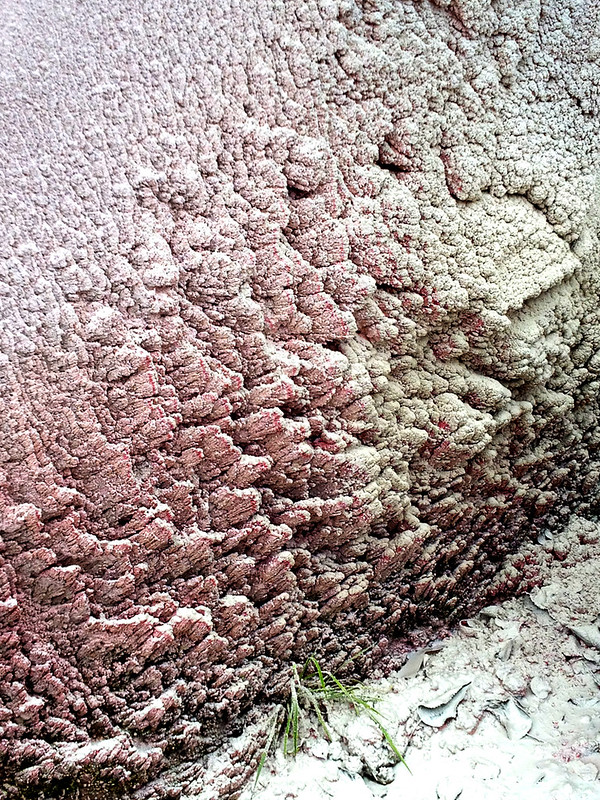
Thus starts my year of Creativity.
|
|
|
|
|
|
|
|
|
|
|
|
Lessons in the porcelain capital
|
|
|
|
My first trip to the porcelain capital of the world opened my eyes to the rich history of ceramics in China. From early on, the Chinese produced ceramics in an “assembly line” sort of fashion, with division of labor whereas various people were responsible for a different part of the process. As a result, a ceramics worker would become expert at his or her step in the production line. For example, a thrower would only focus on throwing the pots, which would then be passed on to the trimmer. The next step was decoration, which would be done by a painter or a carver.
On that first trip to Jingdezhen, my group had the opportunity to learn traditional “blue flower” painting from a qinghua painter with over 20 years’ experience — if interested, you can read the post about what we learned. After returning home and applying the techniques to my work, I realized that I was drawn to this particular form of decoration especially as it intersected with my Western aesthetics.
Upon the encouragement of my hubby and other supportive friends, I decided to go back to Jingdezhen on my own for a very brief residency so that I could learn more as well as spend some time practicing and producing work.
This time around, I had a private lesson with a younger qinghua artist who had a personal interest in both ancient techniques as well as modern applications. He not only painted qinghua, he also collected antique qinghua shards. As such, I had a chance to explore various styles of painting in addition to the more traditional method.
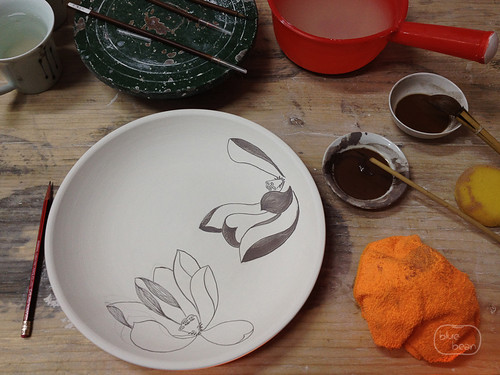
Wanting to make the most of my stay, I also took lessons in overglaze painting and carving. It was rather humbling to realize that I was learning techniques first practiced centuries ago to produce imperial ceramics ware.
Leaving Jingdezhen, I was left with the feeling that there is much, much more to learn. Even amid rapid modernization, the thread of history can be sensed running beneath the ever-changing cityscape of new constructions. The porcelain city is certainly one sitting atop many layers, not only of old broken pieces of pottery from another era, but also of various ancient techniques that have been passed on through time.
|
|
|
|
|
|
|
|
|
|
|
|
A blue raccoon
|
|
|
|
I finished a batch of mugs recently. All of them are wheel-thrown and hand-painted with various “characters” using the traditional Chinese qinghua (blue flower) paint. This raccoon one is my favorite of the bunch.
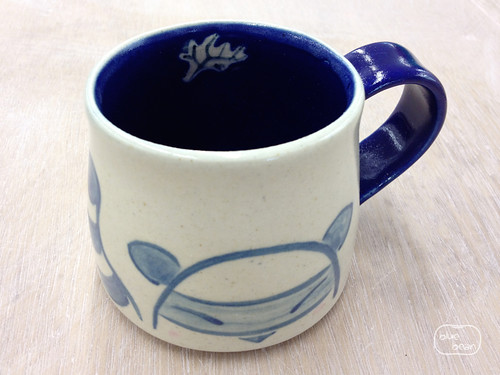
Qinghua painting has been really fun to do… I find myself enjoying it much more than I expected to. To me, the contrast of the cobalt against porcelain or even bare stoneware clay (as shown above) is beautiful. My only frustration with the paint is that it smudges quite easily during any part of the process (even after bisque firing), so the pieces have to be handled very delicately. In any case, if done correctly, the outcome can be quite lovely.
If you’ve been following along, you’ll be aware that I have been playing around with these “Qinghua character” designs ever since I took a qinghua workshop during my trip to Jingdezhen. The decorating and glazing process for this series of mugs is still a bit complicated and involves much waiting (I have lamented a bit on this topic), so I’m working on trying to streamline it in order to minimize further frustration for myself.
In the meantime, I’m gonna enjoy having this cutie on my desk : )
|
|
|
|
|
|
|
|
|
|
|
|
Blue Flower painting
|
|
|
|
Having returned from Jingdezhen, I feel inspired to do more painting on my pottery pieces. More specifically, I would like to do more qinghua painting.
Qinghua refers to the traditional Chinese “blue and white” painting technique that involves the application of cobalt pigment to white porcelain. The Chinese characters for qinghua (青花) translate directly to “blue flower.”
This type of ceramic decoration is still widely practiced in Jingdezhen, so it was amazing to have the opportunity to attend a qinghua painting workshop in the city that has produced more blue and white porcelain pieces than any other in the world. A local artisan with over twenty years of painting experience spent a couple hours with us, demonstrating and explaining the technique.
We were first shown how to prep the green ware pieces for paint application by dusting them and brushing on tea (any tea will do). Then we were taught how to mix the paint to the right consistency, adding a type of gum to the cobalt pigment in order to facilitate a smooth and continuous stroke. The next step was learning how to hold and use two different types of brushes — a small, fine-tipped one to make thin lines, and a bigger “chicken head” brush to fill in larger areas. Lastly, we were taught how to fix mistakes — scratch it off, smooth it over, and start again. We finally got to work on the porcelain green ware that was provided for us to practice on.
Here is one of the pieces I painted prior to glazing and firing. As you can see, the paint is a dark grayish color here.

During the workshop, I learned that qinghua painting requires patience and a steady hand. The pigment can easily smudge with too much handling. Having made some mistakes on my pieces, I didn’t have high hopes for the final product. But I had to wait for a couple of days before I got to see it. After we had completed our pieces, they were sent to the “glaze man” (a person in charge solely of applying glaze to ceramics) before being fired in a public kiln.
When we finally went to pick up the finished pieces, I was pleasantly surprised. I have to say that the pieces turned out better than I expected. They’re not great — the brush strokes are terribly uneven and inconsistent — but the deep blue of the cobalt is so beautiful on its own against the white porcelain. (Note: you can see how thin and translucent the porcelain is as the cobalt on the outside of the vessel is visible.)

I picked up a couple small canisters of qinghua paint to bring home with me, so I’m gonna be trying this technique over the next little while!
|
|
|
|
|
|
|
|
|
|
|
|
Back from the city of porcelain
|
|
|
|
Wow. What an experience. I am super excited to share about my trip to Jingdezhen (a.k.a. the porcelain capital of China), but will need some time to absorb and process all the sights and sounds and information from the past few days… and a lot more time to sort through all my photos!
In the meantime, check out these awesome figurines I spotted at one of the local public kilns (notice the orange glow of the large and very hot kiln in the background) — these guys look like they’re ready for a good kungfu fight; that is, if they’re not already engaged in one!

|
|
|
|
|
|
|
|
|
|
|
|
Countdown to Jingdezhen
|
|
|
|
Here is a random photo of some shavings from my mishima work today. I was in the middle of cleaning up and stopped to snap a shot — I like how it looks like sand art.
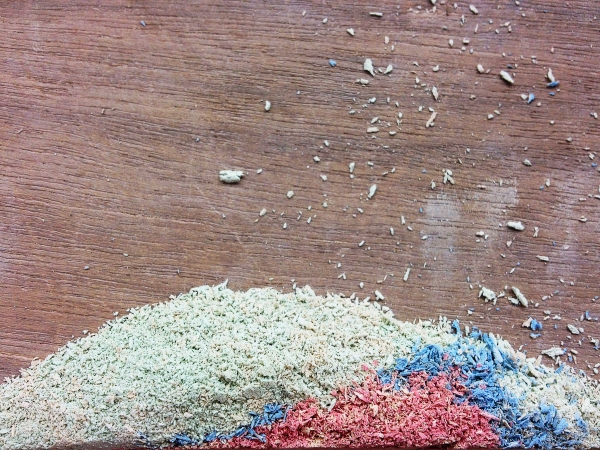
On to much more exciting news…
It’s official. I’ve booked the flights and hostel room and paid the rest of the trip fees for my upcoming trip to Jingdezhen. I’ll be flying on Friday.
Jingdezhen is a city situated in the hills of Jianxi province in China. It has a long history of producing porcelain, in particular the blue and white type, also known as “china.” In fact, it is often referred to as the “porcelain capital” of the country and has been the center of the industry for over 1,700 years.
While I have a feeling the city has probably lost some of its historical charm with the ongoing mass production of porcelain ware, I am still excited to tour some studios and watch local artisans at work. We’ve got a pretty packed schedule, which includes a Qinghua (traditional Chinese blue and white painting) workshop, a visit to the Sanbao ceramics village, and time to explore the local creative market.
I will report back with photos!
|
|
|
|
|
|
|
|
|
|
|
|
From consumer to creator
|
|
|
|
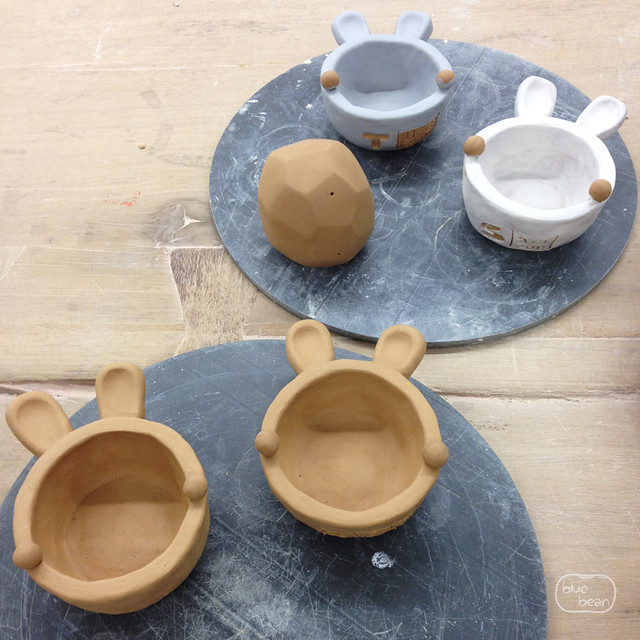
Up until half a year ago, I was merely a consumer of ceramics and not a creator. While I had dabbled in hand built pottery during a high school art course, I had never seriously spent time considering the infinite possibilities that ceramics offer as a creative outlet. After getting my hands dirty again a few months ago, there was no going back. Pottery is such a different art form compared to photography, which in the digital age has become sterile and mess-free (no risk here of splashing or inhaling hazardous chemicals while developing my jpegs).
Having spent some time concentrating on developing photography skills, I found pottery accessed a completely different creative side in me. Photography is all about capturing and fixing in time something that already exists — light, objects, space. By contrast, pottery is about changing, over time, an existing, usually formless, material into something else entirely.
I have to say it’s very addictive.
|
|
|
|
|
|
|
|
|
|
|
|
  |
|
|

